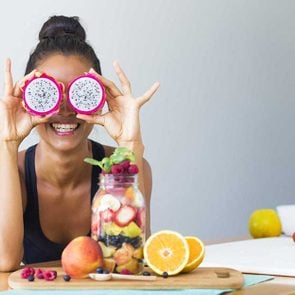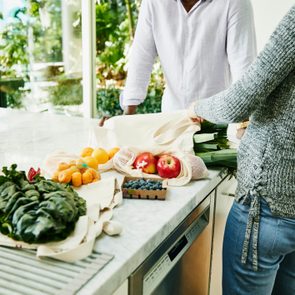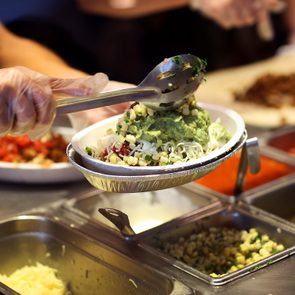7 Great Vegan Sources of Iron—and How to Eat Them
Updated: Apr. 28, 2021
Iron can be challenging to obtain for vegans. Here are some of the best plant sources of iron, from dark chocolate (yes) to lentils, and how to add them to a plant-based diet.
Our editors and experts handpick every product we feature. We may earn a commission from your purchases.
Iron for vegans
Meat is considered to be one of the best sources of iron in your diet, but if you’re a vegan, it can seem challenging to find iron-rich meat alternatives.
Luckily, iron is available in a variety of foods and can be taken as a supplement.
But not all iron in foods, including iron-fortified foods, is created equal. Heme iron is the type found in animal products and non-heme iron is found in plant foods and iron-fortified and iron-enriched foods. Heme iron is more absorbable.
“The iron content in plant-based foods is not as high and not as absorbable as in animal foods, so someone who is vegan needs to be aware of getting enough iron,” says Tara Collingwood, RDN, a sports dietitian in Orlando.
Here’s what you need to know about the importance of iron and how to find the best vegan iron sources to add to your diet.
(Are you a vegetarian? Here are the best high-iron foods.)
Why iron is important
If you have blood in your veins (which you do), iron is essential. That means everyone needs this mineral.
Iron plays a key role in blood production and is an essential part of hemoglobin, which is found in red blood cells. Hemoglobin carries oxygen from the lungs to your body tissues, allowing you to thrive.
A lesser amount of iron is found in myoglobin in muscle cells, and provides necessary oxygen, too.
The body also needs iron for the overall functioning of cells and the development of the brain and certain hormones. Without it, the body can’t grow.
Everyone loses a bit of iron when urinating or having a bowel movement—and through the skin and gastrointestinal tract.
Though, the main loss occurs when women have their periods due to blood loss. It’s why women of child-bearing age need to be particularly iron conscientious.
Iron can be in short supply for plant-based eaters
If you follow a vegan or plant-based diet, it’s important to pay close attention to iron intake.
“Vegans (and vegetarians) have a high prevalence of depleted iron stores,” says DJ Blatner, RDN, author of The Flexitarian Diet. “A recent research review [published in the American Journal of Lifestyle Medicine] found a higher proportion of vegans/vegetarians, compared to nonvegetarians, had iron-deficiency anemia; this is especially true for premenopausal vegetarian women.”
Anemia means that the blood doesn’t have enough healthy red blood cells.
Symptoms may range from none when iron-deficiency anemia is mild, to fatigue, chest pain, and shortness of breath when severe.
“I work with a lot of athletes, so even a little bit of anemia or iron deficiency can affect their performance,” says Collingwood.
Iron deficiency can occur from simply a low iron intake.
It may also happen when getting mainly or exclusively non-heme iron from plant foods, in which the iron is basically blocked due to naturally occurring phytates and oxalates in plants, which are sometimes known as antinutrients.
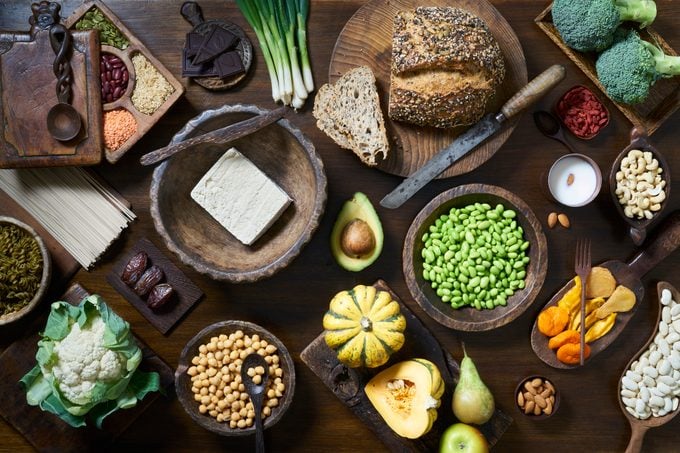
Overcoming obstacles to iron absorption
“It’s absolutely possible to get enough iron from plant-based sources, but you do have to be thoughtful about it,” says Jackie Topol, a registered dietitian and culinary nutritionist.
Try these smart plant-based strategies to increase absorption of non-heme iron you can absorb.
- Pair non-heme iron with vitamin C: For instance, squirt lemon onto steamy leafy greens or top a bodacious bean burrito with tomato or papaya salsa.
- Pick plants wisely: Ideally pick lower oxalate veggies, like broccoli, cauliflower, zucchini, sweet potatoes, and kale, as a swap for higher oxalate veggies, such as potatoes, turnips, beets, and yams. Also, toast nuts and seeds or soak beans to help reduce phytates.
- Cook strategically: You can obtain more iron by cooking in cast iron cookware. (Don’t have any? Start with a standard cast iron skillet.)
- Let the body adapt: “The Academy of Nutrition and Dietetics position paper on vegetarian and vegan diets reminds us that people following a vegan diet do adapt and absorb plant iron (non-heme) more effectively over time,” says Blatner. Though, she cautions, “It’s still a nutrient to pay close attention to.”
How much iron do you need?
The Food and Drug Administration’s Daily Value (DV) for iron is 18 milligrams (mg) per day. When iron is included on a food label, this number is used to determine percent of the DV you’re getting for one serving of food.
However, the specific Recommended Dietary Allowances (RDAs) for iron vary widely. Here’s what nonvegetarians need:
- Age 14 to 18: 11 mg males; 15 mg females; 27 mg during pregnancy; 10 mg while breastfeeding
- Age 19 to 50 years: 8 mg males; 18 mg females; 27 mg during pregnancy; 9 mg while breastfeeding
- Age 51 years and up: 8 mg
Females need more iron due to menstruation. When pregnant, additional iron is needed for more blood production to ultimately supply oxygen to the fetus. For people following a vegetarian (including vegan) eating plan, the RDA is 1.8 times higher.
In other words, you’ll want nearly double the RDA numbers above. This is due to a lower bioavailability of iron in a plant-based diet compared to a nonvegetarian eating plan.
Should you take an iron supplement?
Ideally, you should have bloodwork to see if you need supplemental iron.
“Absolutely an iron supplement is necessary for some people following a vegan diet,” says Blatner. When needed, she suggests a gentle, non-constipating iron, like ferrous bisglycinate, as well as one including vitamin C, folate, and vitamin B12.
Collingwood advises choosing a slow-release iron supplement to help prevent a potential constipation side effect (plus, she highly encourages reading labels for iron-fortified foods).
And Topol cautions: “There is an upper limit for iron and when we surpass that level there can be adverse health effects.”
Speak with your dietitian or doctor if you go the supplement route to close an iron gap.
You should exercise caution and know that you can get too much iron. If your intake consists of a combination of supplemental forms of iron, such as iron-fortified meal replacements, iron-fortified cereal, and iron supplements, iron overload is more likely to occur.
Taking more than 20 mg iron per kilograms (kg) body weight at once from supplements or medications may result in gastrointestinal issues, like abdominal pain, vomiting, or constipation, according to the National Institutes of Health Office of Dietary Supplements.
In rare cases, excessive one-time intakes of 60 mg iron per kg or higher may lead to multisystem organ failure and possibly death. But if you weigh 68 kg—that’s 150 pounds—it translates to taking over 4,000 mg iron. That’s impossible when just eating wholesome plants.
For all people ages 14 and up, the Tolerable Upper Levels (ULs) for iron from food and supplements is 45 mg per day. Staying under this amount can help prevent gastrointestinal issues.
Remember, focusing on iron from food is always the first choice.
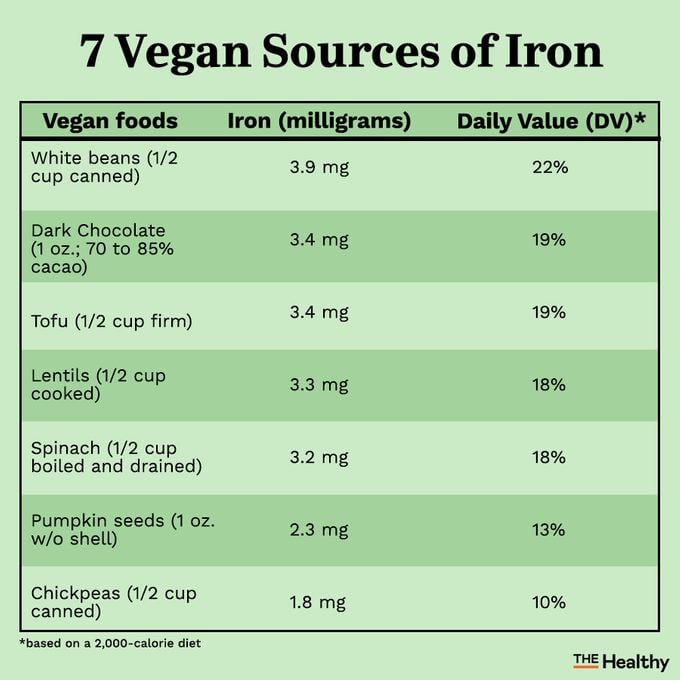
Vegan foods high in iron
You can’t go wrong by eating nourishing pulses, leafy greens, nuts, seeds, quinoa, white mushrooms, canned tomatoes, potatoes, and dried fruits. They provide notable amounts of iron … and deliciousness. Here are seven of the best (and easy to eat) naturally occurring vegan sources of iron—including one surprising pick.
White beans
1/2 cup canned white beans = 3.9 mg iron (22 percent DV)
Other highlights: 6.3 g dietary fiber (23 percent DV), 9.5 g protein (19 percent DV), 595 mg potassium (13 percent DV), and 85 mcg folate (21 percent DV)
White plant foods can offer an abundance of good nutrition. And they’re a standout among other pulses related to their iron content. This includes cannellini beans, navy beans, and great northern beans. White beans contain high levels of resistant starch, which means they’re your friend in maintaining a healthy weight and good gut.
Try this: Whirl white beans into a dip, sprinkle onto salads, and plop into soups. And instead of heavy cream, blend white beans into a soup to create plant-based creaminess, like in Roasted Orange Bell Pepper Soup.
Maximize iron absorption: Toss lemon vinaigrette and fresh herbs with canned white beans for a satisfying side.
Dark chocolate
1 ounce dark chocolate with 70 to 85 percent cacao = 3.4 milligrams iron (19 percent DV)
Other highlights: 3 g dietary fiber (11 percent DV), 65 mg magnesium (15 percent DV), and 3.3 mg zinc (30 percent DV)
Generally speaking, the more bitter (or darker) the chocolate, the better it is for you. It provides cocoa polyphenols that have antioxidant and anti-inflammatory benefits. Choosing chocolate that’s at least 70 percent cacao is a good goal. Using unsweetened chocolate and unsweetened cocoa powder in recipes is ideal, too.
Try this: Shave dark chocolate using a vegetable peeler and use as a scrumptious garnish on a healthy smoothie. Use bittersweet instead of semi-sweet or milk chocolate chips in baking. Savor a sweet, nutrient-rich treat by whirling up Vegan Chocolate Mousse; it uses dark chocolate and cocoa powder.
Maximize iron absorption: Drizzle (or dunk!) berries, pineapple, or clementines with melted dark chocolate.
Tofu
1/2 cup firm tofu = 3.4 mg iron (19 percent DV)
Other highlights: 3 g dietary fiber (11 percent DV), 22 g protein (44 percent DV), 239 mg phosphorus (19 percent DV), and 2 mg zinc (18 percent DV)
Tofu is soybean curd. It’s loaded with plant protein, contains health-protective isoflavones, and may reduce the risk of heart disease. A study published in the journal Circulation in 2020 finds an 18 percent lower risk of heart disease is possible with people eating at least one serving of tofu per week compared to those rarely eating it.
Look for non-GMO tofu as a wholesome pick. Choose any types or textures, from silken to extra-firm. Other soybean products, such as tempeh and natto, are significant iron sources, too.
Try this: Blend silken tofu into a velvety smoothie. Scramble firm tofu like eggs. Toss extra-firm tofu into stir-fries. And simply roast it with veggies on a sheet pan, like in Peanutty Sprouted Tofu “Stir-Fry” Sheet Pan Dinner.
Maximize iron absorption: Finish a tofu stir-fry with a splash of orange juice.
Lentils
1/2 cup cooked lentils = 3.3 g (18 percent DV)
Other highlights: 7.8 g dietary fiber (28 percent DV), 9 g protein (18 percent DV), 178 mg phosphorus (14 percent DV), 179 mcg folate (45 percent DV), and 1.3 mg zinc (12 percent DV)
Lentils are packed with polyphenols and they may play a role in reducing risk of obesity, diabetes, heart disease, and cancer. Collingwood notes that they’re filling and delicious, too. For bonus enticement, choose various lentil colors—they come in a virtual rainbow of varieties.
Try this: Collingwood suggests using lentils in soup, salad, or casseroles—and made into patties. Blatner loves lentil tacos. “Just sauté cooked lentils with your favorite taco seasoning,” she says. And you’ve definitely got to try her recipe for Vegan Lentil “Meatballs.”
Maximize iron absorption: Simmer a handful of dry red lentils into a pre-made tomato soup and, as a bonus, finish with lemon juice and basil or lime juice and cilantro.
Spinach
1/2 cup boiled and drained spinach = 3.2 mg iron (18 percent DV)
Other highlights: 2.2 g dietary fiber (8 percent DV), 132 mcg folate (33 percent DV), 8.8 mg vitamin C (10 percent DV), and 5,650 mcg beta carotene
While you’ll get iron from raw or cooked spinach, cooking it helps you absorb more of its iron. “Cooking spinach makes it even easier to eat a larger amount since it shrinks so much” adds Blatner. “Spinach also has vitamin C, which helps its iron be more absorbable.” Plus, it provides lutein and zeaxanthin, offering eye health benefits.
Try this: Collingwood suggests whirling spinach into smoothies; adding it to veggie lasagna or pizza; tossing it into a salad or sandwich; or simply sautéing it. Blatner encourages including spinach in morning tofu scrambles and as a base for leftovers. She’s also “obsessed” with making Green Juice Prep Bags, which feature spinach.
Maximize iron absorption: Plop fresh strawberries (and strawberry vinaigrette!) onto fresh spinach salad.
Pumpkin seeds
1 ounce pumpkin seeds without shell = 2.3 mg iron (13 percent DV)
Other highlights: 8.5 g protein (17 percent DV), 156 mg magnesium (37 percent DV), 333 mg phosphorus (27 percent DV), and 2.2 mg zinc (20 percent DV)
Also known as pepitas, pumpkin seeds are nutrient-rich and packed with benefits in every little bite. Since they’re rich in magnesium, eating pumpkin seeds may offer heart and bone health benefits, as well as play a role in managing a healthy blood pressure and preventing migraines.
Keep in mind that other seeds also contain iron. For example, one tablespoon of chia seeds contains 1.1 mg, three tablespoons of hemp seeds contain 2 mg, and one tablespoon of flaxseeds contain 0.6 mg of iron.
Try this: Sprinkle pumpkin seeds onto anything you wish. Swap them in place of croutons on salads and soups. Blend up a pumpkin seed-based pesto. And enjoy a dish featuring pumpkin seed tofu (like Pumfu) and pumpkin seeds, such as Savory Oatmeal with Greens, Pumpkin Seed “Tofu” & Tart Cherry Reduction.
Maximize iron absorption: Stir pumpkin seeds into salsa and enjoy wherever you like salsa.
Chickpeas
1/2 cup canned chickpeas = 1.8 mg iron (10 percent DV)
Other highlights: 6.6 g dietary fiber (24 percent DV), 7.4 g protein (15 percent DV), and 120 mg phosphorus (10 percent DV)
Since chickpeas are an excellent source of plant-based protein and fiber, they’re quite satiating, which is helpful for weight management. The popular pulse offers an array of other potential health benefits, including for reproductive health and type 2 diabetes. Plus, chickpeas are healthful of the planet since they’re nitrogen-fixing crops, which ultimately reduces need for fertilizer.
Try this: “Top a salad with chickpeas; make a stew with chickpeas and other vegetables; or blend into hummus,” says Topol. Do dip into Topol’s Za’atar Flaxseed Hummus.
Maximize iron absorption: Scoop up hummus with colorful bell pepper strips.

















